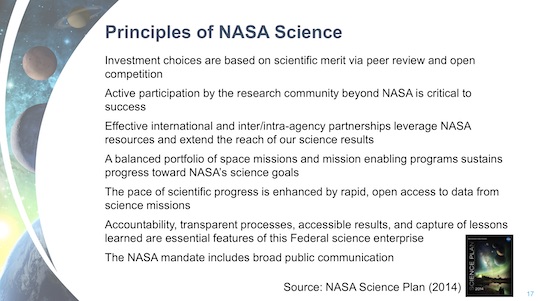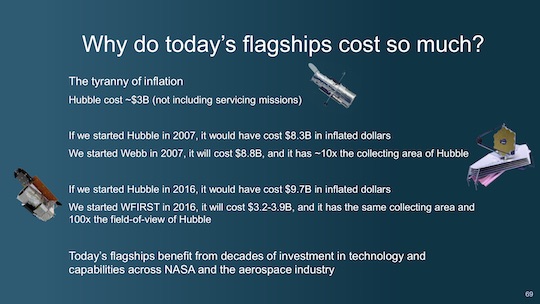More Confusing Slides From SMD
 Keith’s note: Earlier today I featured a silly slide shown by NASA Astrophysics Division Director Paul Hertz to the Astro2020 Decadal Survey Committee Meeting at the National Academy of Science (Mocking Cost Overruns And Schedule Slips At NASA (Update)). If you download his entire presentation (link) you will see that there several slides which serve one purpose: to confuse anyone who tries to understand what they are trying to say.
Keith’s note: Earlier today I featured a silly slide shown by NASA Astrophysics Division Director Paul Hertz to the Astro2020 Decadal Survey Committee Meeting at the National Academy of Science (Mocking Cost Overruns And Schedule Slips At NASA (Update)). If you download his entire presentation (link) you will see that there several slides which serve one purpose: to confuse anyone who tries to understand what they are trying to say.

In this slide (larger). Hertz says NASA is “not a science agency”. Then he says that what “NASA is a mission-oriented agency, and science is the purpose and consequence of our space missions”. So Science is what NASA does. And NASA is an agency – in this case an agency that does science. So why is NASA not a “science agency”? There is a distinction lacking a difference at work here.
“Science” is mentioned multiple times in the National Aeronautics and Space Act of 1958, As Amended. Hertz quotes this Act by saying “… carrying instruments and humans through space” when in fact neither the original or amended version of the Act uses these words. Instead they both say “living organisms through space”. Hertz is trying to spin the language and intent of NASA’s charter to say NASA does not do science – at a workshop where the next decade of space science is being planned. In the process he seems to have confused himself. I can only guess that Hertz changed “living organisms” to “humans” to try and make NASA sound more operational and less scientific.

And then he includes a chart (larger) about “NASA Principles of Science” even though he claims NASA is not a science agency. My brain hurts.

Then there’s this confusing chart (larger) about why flagship missions cost so much. It seems to be saying that if NASA waited longer it would cost more to build things. But that we can now build better things for less money. Hertz then says “we started Webb in 2007, it will cost $8.8 billion and it has ~10x the collection area of Hubble”. OK, so it will be a cool telescope – but what was the original cost of Webb supposed to be? $824.8 million was the advertised sticker price in 2002. By 2010 it had increased to $6.8 billion. But Hertz mentions none of this because the real villan is “the tyranny of inflation” according to the title on this chart. No it wasn’t. Webb’s obscene cost increase is not due to inflation – it is due to the fact that NASA did not know what it would cost when it started and then went on to mismanage the project for a decade – leading to delays and cost increases.
I think most people involved in the Decadal review see through Hertz’s confusing charts. He has been doing this for a long time. That said, at a time when budgets are ever tighter – especially for science – you would hope that the government representatives from agencies who want to spend billions on science could at least use plain language to make their points.
Just sayin’









And he’s chosen by far the most expensive possible mission to compare JWST to. Let’s compare to the other great observatories and see where this comparison comes in.
JWST: “$824.8 million was the advertised sticker price in 2002.”
Your own link shows this to be untrue. That was the TRW contract value at the time, NOT the total program cost. If you’re going to nit-pick details in Paul Hertz’s presentation because you don’t like him, at least get your details right.
Read the release – “Under the terms of the contract valued at $824.8 million, TRW will design and fabricate the observatory’s primary mirror and spacecraft. TRW also will be responsible for integrating the science instrument module into the spacecraft as well as performing the pre-flight testing and on-orbit checkout of the observatory.”
EXACTLY – it is not the cost for the program, but the cost for TRW’s (now Northrop Grumman’s) scope of work.
Yea to build and launch the spacecraft. What part of those words do you not understand?
It does not include any costs to design, build, and operate the science instruments. Which is a huge fraction of the cost of a science mission. If you believe TRW built the entire system that is a misunderstanding.
Ok, let’s jump back in time, and be generous and state that the instrument construction came in at $300M, which would have been considered outrageous. And, as you say, a big fraction of the total cost (> 25%). Now take that combined number ($1.1B) and compare it to the final total cost of >$8B. It’s still an incredible level of cost growth.
I remember all of this discussion happening at the time. If you had walked in with a price tag in the multiple billions, it would have been laughed out of the room.
I’m not sure about astrophysics, but for planetary missions, the payload is usually a small fraction of the overall cost. I think something like 10% to 25% is typical, but it’s been a while since I saw those numbers.
Technically, NASA isn’t committed and the estimated cost is considered an educated guess until the Preliminary Design Review and Key Decision Point C. That was in 2006, and the budget was about $4.5 billion. But when Next Generation Space Telescope first appeared and was sold to NASA and the Astrophysics Decadal Survey, they were talking about under $2 billion. Originally, I think it was about half a billion (although we should add 22 years of inflation to that, just to be fair.)
“Hertz says NASA is “not a science agency”. Then he says that what “NASA is a mission-oriented agency, and science is the purpose and consequence of our space missions”. So Science is what NASA does.”
I think you missed the whole point of what that statement was for. Hertz was telling people, … politely, … that academics were not, and would not be, in control of what NASA does. This goes along with all the confusion during the Bridenstine confirmation hearings, about him not being qualified because he had no science degrees. NASA is *not* to be controlled by academics!
That does not mean NASA cannot do science. It simply means that the progressive political allies of academia will not be controlling what NASA pays attention to as long as the current administration is in power, …again, …politely. Without beating people over the head about it like I’m doing here. Time and time again, I find people unwilling to acknowledge that the basic antipathy of non-progressives is *not* directed toward science, but toward the academic hierarchies that control so much of how science, and what science, is done.
That being because those hierarchies are believed to do so spectacularly corruptly, in cooperation with progressive politicians.
Paul Hertz have you heard of the Shuttle? How about Spacelab? How about Spacelab Life Sciences-1 and -2 (STS 40 and STS 58)? Those were both science missions. Certainly all Spacelab missions had a primary goal of science – such as STS-45 which was ATLAS (Atmospheric Laboratory for Applications and Science) and others.
Today with the ISS, NASA is conducting lots and lots of science. There are Mission Scientists for various disciplines. In most cases, NASA starts with the science and creates a mission to accomplish it.
It sounds goofy to try to make a distinction between missions and the purpose of having that mission. If the “mission” part is in charge do they just fit in “science” on science missions (as opposed to missions to deploy payloads, etc) around the mission?
Actually, I can see what he was trying to say, and I’ve heard it before. I don’t agree or like it, but…
Let’s say someone wanted to learn about the atmosphere of Venus, by sending a spacecraft there to measure isotopic abundances. That would be a fine proposal for a Discovery mission (actually, it has been proposed), and NASA would seriously consider it. Now let’s say someone else had an idea to learn exactly the same thing, but by building a specialized, Earth-based telescope and spectrometry. NASA would just tell him to talk the the National Science Foundation, since that idea isn’t about flying things in space. Same science, one implementation involves a flight mission and the other doesn’t. NASA would consider funding one but not the other. Even the telescope funding NASA provide (e.g. the IRTF in Hawai’i) is partially justified by supporting flight missions.